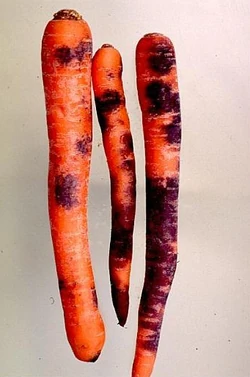| Alternaria | |
|---|---|
| Black rot (carrot) | |
 |
|
| A selection of carrots suffering from black rot | |
| Scientific Classification | |
| Kingdom: | Fungi |
| Phylum: | Ascomycota |
| Class: | Dothideomycetes |
| Subclass: | Pleosporomycetidae |
| Order: | Pleosporales |
| Family: | Pleosporaceae |
| Genus: | Alternaria |
| Species: | Alternaria radicina |
| Synonyms | |
| Macrosporium daucinum Yatel, Mikrobiologicheskii Zhurnal 5: 206 (1938) Pseudostemphylium radicinum (Meier, Drechsler & E.D. Eddy) Subram., Curr. Sci. 30: 423 (1961) |
|
Black rot of carrots (Alternaria radicina) is a storage disease that renders carrot roots useless. The large black lesions are easily seen in store, but there are no symptoms on the growing crop.
Symptoms[]
Symptoms include seedling death, the blackening of the base of the petiole, leaf death, and crown rot of stored roots. Collar rot requires high humidity. The disease is seed transmitted but transmission from the ground is very important. The infection can develop even at 0°C (32°F) on roots stored.[1]
Treatment[]
Burn diseased roots immediately.
Prevention[]
Store roots properly. Do not use the land for carrots next year.
Hosts[]
Hosts of A. radicina include:[1]
References[]
- ↑ a b Guidelines on Good Plant Protection Practice. Organisation for European and Mediterranean Plant Protection.